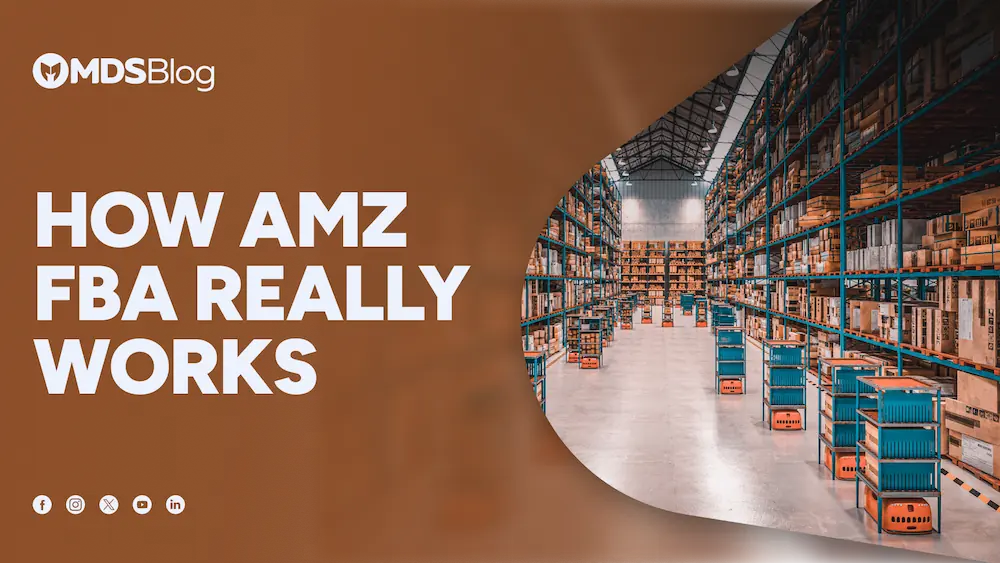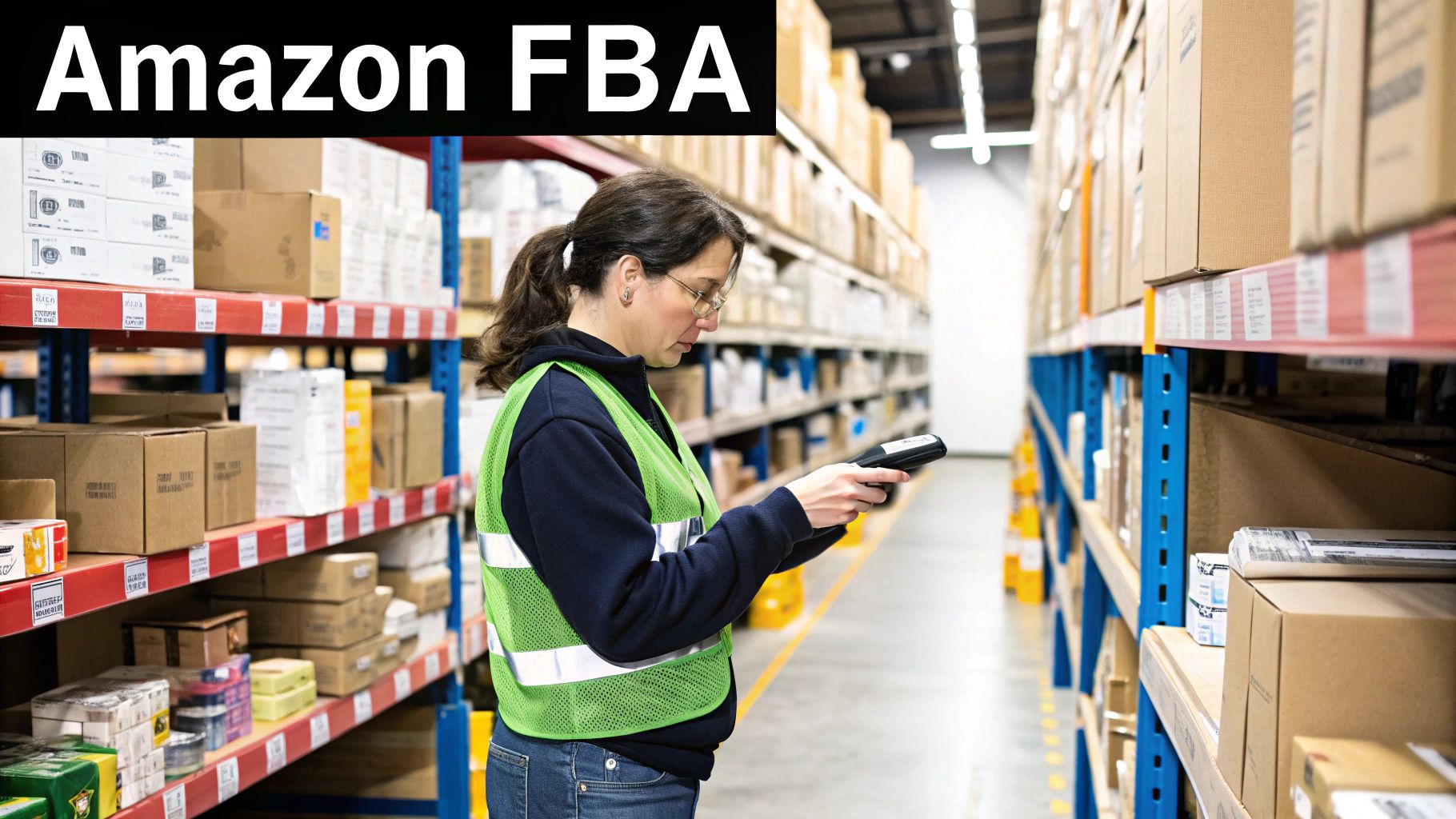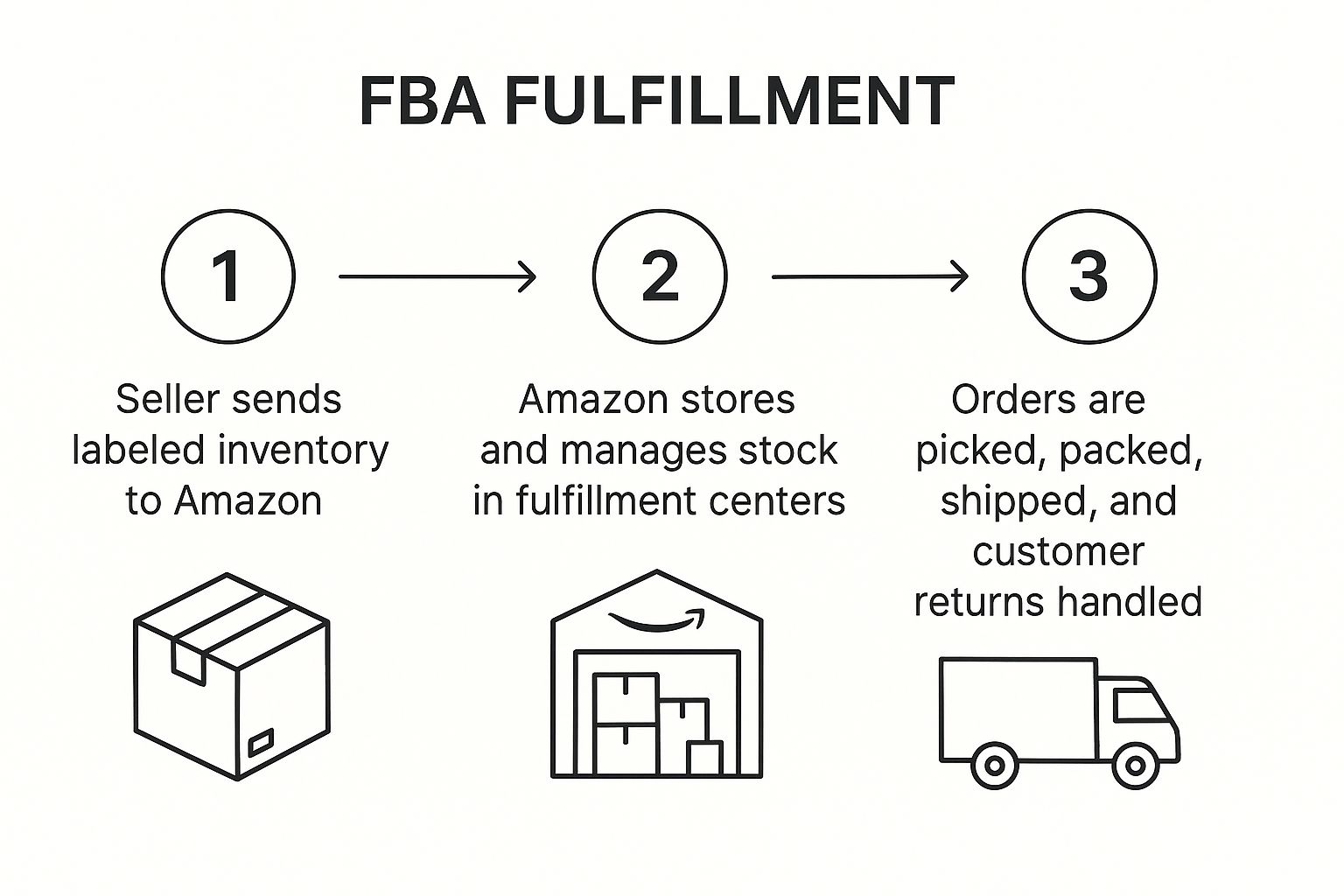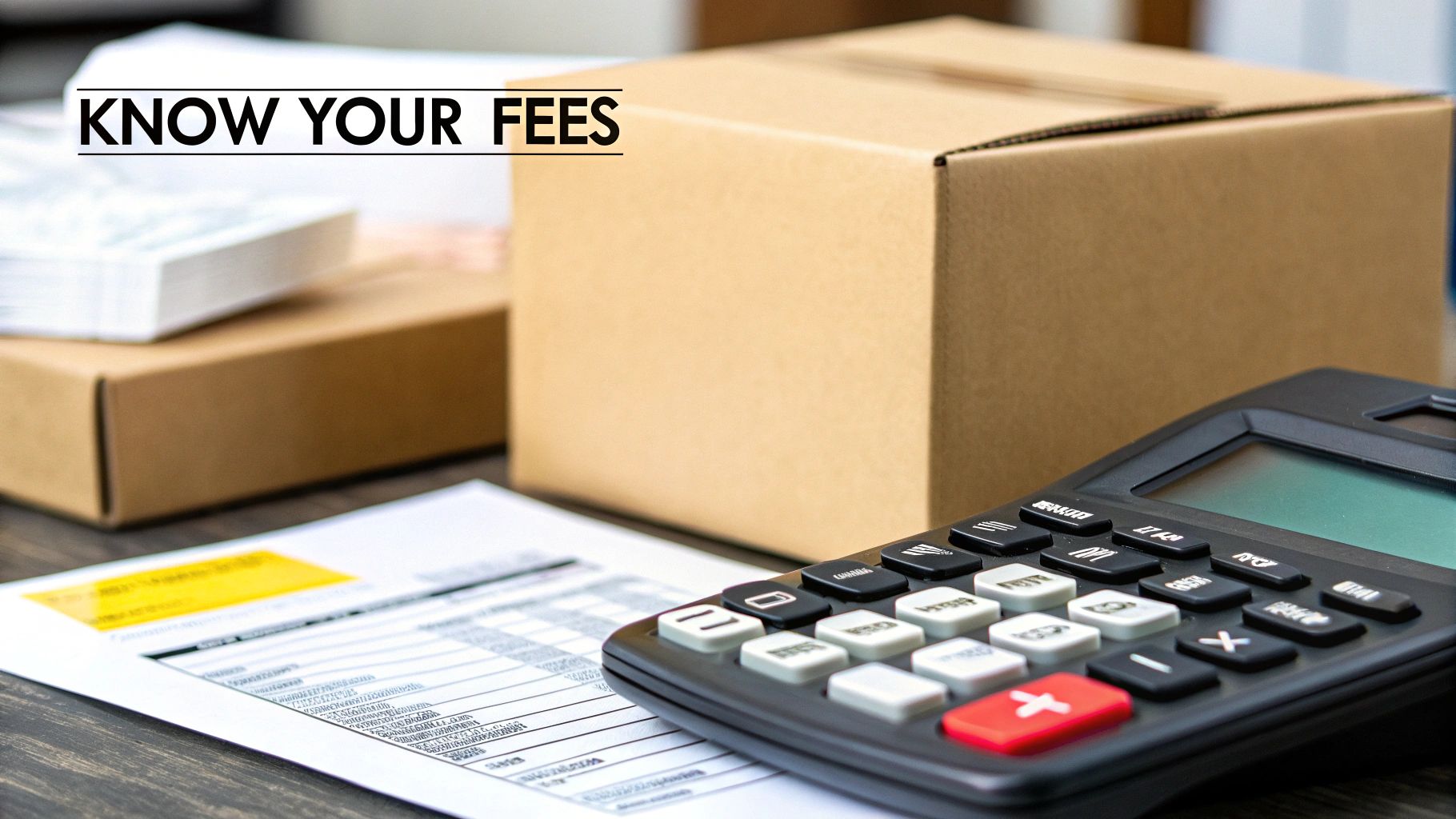Stay Updated with Everything about MDS
Thank you! Your submission has been received!
Oops! Something went wrong while submitting the form.

Chilat Doina
October 16, 2025
Ever run a booming online store but feel like you spend more time buried in bubble wrap and packing tape than actually growing your business? Those endless trips to the post office are a classic growing pain for e-commerce entrepreneurs.
That's where Amazon's FBA comes in. It's their answer to this exact problem.

Think of Fulfillment by Amazon (FBA) as a partnership. You find great products and build your brand, while Amazon handles the messy, time-consuming backend of getting those products to your customers. It's about plugging your business directly into Amazon's massive, world-class logistics network.
If you're new to the term, it helps to understand what FBA stands for in Amazon, but the concept is simple: you sell, they ship.
The FBA model is built on a few powerful pillars that give sellers access to infrastructure they could never build on their own.
This isn't some niche service; it's the engine powering a huge part of the marketplace. By 2025, Amazon is projected to have 9.7 million sellers, and a staggering 82% of them use FBA. That number alone tells you how essential it has become.
To get a clearer picture of who does what, here's a simple breakdown of the FBA process from your perspective.
This table shows exactly where your job ends and Amazon's begins.
StepSeller's ActionAmazon's Responsibility1. Prepare Your ProductsChoose products, list them on Amazon, and prep them according to Amazon’s packaging guidelines.Provides guidelines and tools within Seller Central for creating shipments.2. Ship to AmazonPrint Amazon-provided shipping labels and send your inventory to the designated fulfillment centers.Receives your inventory, scans it, and adds it to your available stock.3. Customer Places an OrderYou focus on marketing your listings and managing your overall inventory levels.Processes the transaction, picks the item from storage, and packs it for shipping.4. Delivery and SupportTrack your sales and FBA fees through your Seller Central dashboard.Ships the order to the customer, provides tracking information, and handles all post-sale customer service and returns.
As you can see, the heavy lifting of logistics is completely off your plate.
By offloading these logistical hurdles, FBA frees up your most valuable resource: time. You can reinvest that time into marketing, product research, and strategic growth—the activities that actually move the needle for your business.
Getting the concept of FBA is one thing, but seeing how the gears actually turn is where it all clicks. So let's walk through the real journey your products take, from sitting in your garage to landing on a customer's doorstep. This is the process that turns your inventory into those coveted, Prime-eligible listings on Amazon.
It all starts in your Amazon Seller Central account. Think of this as the command center for your entire operation. This is where you’ll list your products and then create a shipping plan, which is basically just you giving Amazon a heads-up about what’s coming their way—what products, how many of each, and how you’ve packed them.
Before anything goes out the door, your products need to be prepped to Amazon’s exact standards. Trust me, this is a step you don't want to rush. Getting it right ensures your inventory gets checked in smoothly instead of getting lost in a warehouse the size of a small city.
Every single one of your items needs a scannable barcode. Amazon will generate a unique one for you called the FNSKU (Fulfillment Network Stock Keeping Unit). This label is non-negotiable. It’s how Amazon tracks your specific product and makes sure you get paid when it sells. It's like your product's personal ID card inside the massive Amazon ecosystem.
This infographic gives you a great visual breakdown of the journey.

As you can see, your job is to get the ball rolling by sending your inventory in. After that, Amazon pretty much takes over the whole show.
Once everything is labeled and boxed up, your shipping plan will tell you exactly which fulfillment center (or centers) to ship to. Amazon has hundreds of these warehouses, and they might have you split your shipment and send it to multiple locations. They do this to strategically place your products closer to where they think customers will be, which is the secret sauce behind that super-fast Prime shipping.
You can handle the shipping yourself, but most sellers just use Amazon's Partnered Carrier program. It gives you access to some seriously deep discounts on shipping and makes the whole process easier since you can print the labels right from Seller Central.
For bigger shipments, especially if you're sourcing from overseas, it often makes sense to bring in the pros. If that's you, it's worth reading this guide on using freight forwarders for Amazon FBA.
The moment that carrier picks up your boxes, you've officially passed the baton. Your job shifts from a physical one—lugging boxes—to a digital one, where you're monitoring sales and inventory levels from your computer.
When your shipment arrives at the warehouse, Amazon’s team kicks into high gear. Here's a look at what they handle from this point on:

While the hands-off convenience of FBA is a huge selling point, it’s certainly not free. To build a profitable brand, you need a crystal-clear picture of the fee structure. Think of it as a pay-as-you-go service where you’re charged for the specific resources you use, from warehouse shelf space to the labor involved in shipping.
These costs aren't hidden, but they are detailed. If you don't account for them, they can chew through your profits and turn a potential bestseller into a financial headache. Let's break down the main fees you'll run into so you can calculate your margins with confidence.
At its heart, the FBA cost structure is built on two main pillars. Every seller using the service will see these fees, which form the foundation of what you pay Amazon for taking care of your logistics.
These two costs go hand in hand. The fulfillment fee is a per-order charge, while the storage fee is a constant operational cost. Now, let’s get into how they actually calculate these.
Amazon doesn't just slap a flat rate on everything. The fees are directly tied to your product's physical characteristics and how long it sits on their shelves. This system is designed to make you pay proportionally for the resources your items use up.
The Fulfillment Fee is determined by your product's size tier (like small standard, large standard, or oversize) and its shipping weight. It’s simple, really: smaller, lighter items are way cheaper to fulfill than big, bulky ones. A paperback book will have a much lower fulfillment fee than, say, a microwave.
Likewise, Monthly Storage Fees are calculated based on the daily average volume (in cubic feet) your inventory occupies. These rates also change with the seasons, spiking during the peak holiday rush from October to December when warehouse space is pure gold.
The secret to managing FBA costs is understanding the relationship between your product’s size, weight, and how fast it sells. A fast-selling, small item is the dream FBA product. A slow-moving, oversized one can get expensive, fast.
Beyond the two main fees, a few other charges can pop up on your statement. Knowing about these will help you dodge unexpected expenses and keep your inventory management in good shape.
And don't forget the Amazon Referral Fee, which is completely separate from FBA fees. This is the commission Amazon takes on every single sale (usually 8-15%) just for the privilege of selling on their marketplace. If you want to go deeper, our guide on the Amazon Referral Fee breaks it all down. Getting these numbers right is the first step to figuring out if FBA makes sense for your products.
So, why do so many sellers get on board with FBA? It’s not just about saving a few trips to the post office. Choosing Fulfillment by Amazon is a strategic move, one that completely changes how you operate on the platform and unlocks some serious growth potential.
The biggest game-changer, hands down, is that your products instantly become Prime-eligible. This isn't just a little badge next to your listing; it's a golden ticket. With that Prime logo, you get immediate access to a massive and incredibly loyal customer base that’s been trained to look for fast, free shipping. It's the ultimate seal of approval on Amazon.
Take a look at any popular product on Amazon, and you'll likely see multiple sellers offering the same item. But here's the thing: the vast majority of sales—we're talking over 80%—happen through the "Buy Box." That's the big, prominent button that says "Add to Cart" or "Buy Now."
Amazon's algorithm is picky about who gets that coveted spot. It looks at price, seller performance, and—this is the crucial part—your fulfillment method.
Using FBA gives you a massive leg up in winning the Buy Box. Why? Because Amazon trusts its own logistics network more than anyone else's. When you let them handle the shipping and customer service, their algorithm views your offer as more reliable, giving you a powerful advantage over sellers who are packing boxes in their garage.
This competitive edge is a huge reason why 82% of active sellers globally were using FBA as of 2025. With around 220 million Prime members worldwide, and 74% of them filtering specifically for Prime-eligible items, the sales potential is enormous. You can dive deeper into the numbers with these FBA seller statistics on redstagfulfillment.com.
Beyond the immediate sales bump, FBA gives you something just as valuable: your time back. By handing off the most time-consuming parts of e-commerce, you're free to focus on what actually grows your business—sourcing new products, marketing your brand, and thinking about the big picture.
Just think about everything you get to offload:
Letting Amazon handle the day-to-day grind effectively removes the physical ceiling on your growth. You can scale from selling 10 units a day to 1,000 without having to hire a single warehouse employee.
This model is really just a powerful form of outsourcing. In fact, many of the FBA advantages mirror the broader benefits of third-party logistics (3PL), giving you scalable fulfillment without the massive overhead. It's what allows you to run a global business from a laptop, turning a manual, labor-intensive operation into a much smarter, more strategic one.

While Fulfillment by Amazon gets a lot of the spotlight, it’s not the only game in town. The other side of the coin is Fulfillment by Merchant (FBM), the DIY path where you, the seller, are in the driver's seat for storage, packing, shipping, and all customer service.
Picking your path is one of the most critical decisions you'll make. It’s not just about who puts a label on a box—it directly shapes your profit margins, your daily workload, and how customers see your brand.
Think of FBA as the "done-for-you" option, where you pay for convenience and that coveted Prime badge. FBM, on the other hand, is the hands-on approach. It gives you more control and can seriously lower your costs, if you have your logistics sorted out. There's no single right answer here; it all boils down to your product, your business model, and what you’re capable of handling.
Let's cut through the noise. This table breaks down exactly what you're getting (and giving up) with each fulfillment method, side-by-side.
FeatureFulfillment by Amazon (FBA)Fulfillment by Merchant (FBM)Prime EligibilityAutomatic. Your products get the Prime badge, which is a massive sales driver.Not automatic. You have to qualify for Seller Fulfilled Prime (SFP), and Amazon is rarely open to new applicants.Shipping CostsYou pay Amazon's FBA fees, which are often cheaper than standard rates thanks to their massive shipping discounts.You're on the hook for all shipping costs. You have to negotiate your own rates, which can get pricey for heavy or bulky items.Inventory ControlYou have less direct control. Your stock is in Amazon's network, and you'll pay storage fees and penalties for slow-moving products.You have complete control. Your inventory is your own, ready to be used for Amazon sales or any other channel you sell on.Customer InteractionAmazon handles almost all customer service and returns. It’s a completely hands-off experience for you.You manage every customer question, return, and issue. This lets you build a direct relationship with your buyers.
Seeing them laid out like this makes the core trade-off crystal clear. You're essentially deciding between paying for Amazon's world-class logistics or keeping that control (and potentially more of your margin) in-house.
Fulfillment by Amazon is practically built for sellers who are all-in on rapid growth and want to keep their operations as simple as possible. If this sounds like you, FBA is probably a fantastic fit.
On the flip side, going the FBM route can be a much more strategic—and profitable—move in certain situations. It’s the go-to for sellers who need total control or whose products just don't work with the FBA fee structure.
Consider FBM if this sounds familiar:
Getting your FBA business set up is one thing. Turning it into a real, profitable brand is a whole other ballgame. It's not about just shipping boxes to Amazon and hoping for the best; it's about building a finely tuned operation that hinges on smart product choices, airtight inventory control, and never-ending optimization. This is the playbook for building something that lasts.
The absolute bedrock of a successful FBA business is picking the right products. This isn't about gut feelings. It’s about diving into the data to find items that have steady demand but aren't drowning in competition. Your sweet spot is a product that's small, light, and durable—these traits directly slash your FBA fulfillment and storage fees, which pads your profit margin on every single sale.
Nailing your product selection is how you start to truly tap into FBA's power. The payoff is huge; sellers who switch to FBA see their sales jump by an average of 20-25% compared to sellers shipping orders themselves. And this isn't just a big-city phenomenon. Thanks to Amazon's incredible logistics, sellers in rural areas have seen their FBA businesses grow by a staggering 30% year-over-year. You can dig into more stats like these and other Amazon marketplace trends over at amzprep.com.
Once you've got a winner, your next obsession becomes inventory. This is a high-stakes balancing act. If you run out of stock, your sales come to a screeching halt, and your product's search ranking on Amazon can take a nosedive it may never recover from.
But the flip side is just as dangerous. Overstocking means you're bleeding money on monthly storage fees. Let those products sit too long, and you'll get hit with long-term storage penalties that can wipe out your profits entirely. The goal is to keep a lean but consistent supply, enough to cover your sales velocity without letting products collect dust on a warehouse shelf.
Successful FBA sellers treat their inventory like a strategic asset, not just boxes on a shelf. They use forecasting tools and sales data to know precisely when to reorder, turning their supply chain into a competitive advantage.
Think of your product listing as your digital storefront. The Prime badge gets eyes on your product, but your listing is what closes the deal. It needs to be a masterclass in persuasion, turning casual browsers into committed buyers.
When you have the fundamentals locked down, it's time to hit the accelerator. FBA isn't just a way to sell in your home country; it's your key to a global logistics network.
Think about expanding internationally through Amazon's global selling programs. FBA makes this surprisingly simple, letting you store and sell products in places like Canada, Mexico, and all across Europe without the headache of setting up your own international warehouses.
You can also use Multi-Channel Fulfillment (MCF). This program lets you tap into your FBA inventory to fulfill orders from your own website or other marketplaces. Essentially, Amazon becomes the logistics powerhouse for your entire brand, not just your Amazon sales. To get this set up efficiently, many top sellers work with third-party logistics partners; you can learn all about them in this guide to Amazon prep centers.
Even with the roadmap laid out, you’ve probably got some lingering questions. Let's tackle a few of the most common ones that pop up for sellers who are just dipping their toes into the FBA world.
Absolutely. Don't let a small bank account stop you. While having more cash to play with never hurts, plenty of seven-figure sellers got their start by being scrappy and smart.
The trick is to focus on products you can source cheaply but still sell for a healthy profit. You don't need to buy hundreds of units at first. Order a small test batch to see if people are actually buying. This keeps your upfront risk super low and avoids racking up storage fees while you're still learning the game.
Think small, light, and tough. Those are the golden rules. Why? Because size and weight are the biggest factors in your FBA fees. The smaller and lighter your product, the less you'll pay Amazon to ship and store it.
You're looking for that sweet spot: consistent demand without a million other sellers fighting over it. As a beginner, you'll want to steer clear of these categories:
Nope, not at first. You can get started right away as a sole proprietor, using your own name and tax info. It's the simplest, fastest way to get your foot in the door without getting bogged down in legal paperwork.
But—and this is a big but—once you start seeing some real sales momentum, setting up an LLC or another formal business entity is a smart move. It's all about protecting your personal assets (like your house and car) from any business liabilities. It can also open up some nice tax advantages down the road. When you feel like you're getting close to that point, have a chat with a lawyer or accountant to figure out the timing.
At Million Dollar Sellers, we've seen it all when it comes to scaling an e-commerce business from a kitchen table idea to a powerhouse brand. Our private community is where the world's top Amazon and DTC sellers trade the strategies that actually move the needle. If you're serious about growing faster and smarter, see if you have what it takes to join us. Learn more about Million Dollar Sellers.
Join the Ecom Entrepreneur Community for Vetted 7-9 Figure Ecommerce Founders
Learn MoreYou may also like:
Learn more about our special events!
Check Events